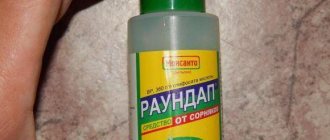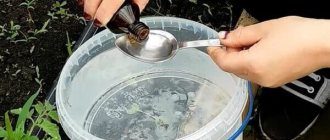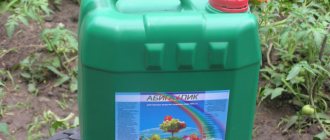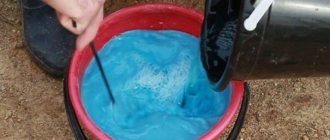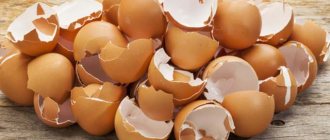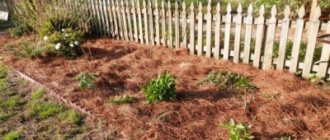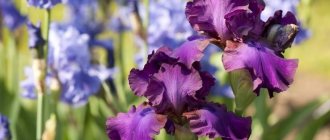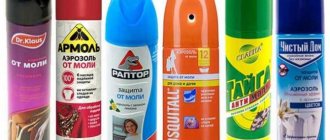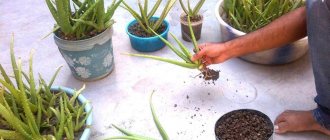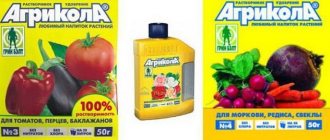Every summer resident, having his own garden or vegetable garden, should know a couple of simple tricks that will help him, using this cheap product, effectively solve this or that problem. It is very disappointing when, out of ignorance, flowers or fruits and vegetables perish, which could have been saved using the penny powder familiar in the kitchen. Every grandmother who keeps a vegetable garden shares secrets on how to preserve and preserve the harvest. You can also get good advice from them on how to salvage the results of your hard work. One such proven cheap remedy for your garden is baking soda. Using soda for a vegetable garden is a fairly simple skill, and this useful product can be used for various purposes.
Soda solution protects against leaf-eating caterpillars
Pests like leaf-eating caterpillars can quickly destroy cabbage and other similar plants, leaving the summer resident without a harvest. To prevent this from happening, mix a special solution for cabbage: flour and soda in equal parts, then sprinkle the cabbage leaves and soil nearby with this mixture. Baking soda will help the grapes by protecting them from gray rot and giving the fruit more sugar and flavor. When the berries begin to ripen, spray the berries with a 5% soda solution. You will appreciate the taste of grapes ripened after such procedures!
Getting rid of aphids
Aphids are a real problem for summer residents. Due to their large numbers, small insects that gather in huge colonies mercilessly destroy plants, sucking out their cell sap. Along the way, the pests release a poison that causes deformation and death of foliage, curvature of apical shoots and their stunting. The surface of the leaves becomes contaminated with sweet secretions, disrupting the normal functioning of garden and vegetable crops. Rapidly multiplying and producing up to fifty colonies over the summer, aphids are capable of causing enormous damage to any, even the most well-groomed, summer cottage.
In the line of proven folk methods of combating this pest, soda ash effectively demonstrates its properties. Application in the garden against aphids is recommended by spraying damaged crops with a solution based on onions. To prepare it, a glass of onion ground through a meat grinder must be diluted in 10 liters of water. Add a tablespoon of soda ash to this. It is recommended to spray the damaged plants generously with the resulting mixture, and the last procedure must be carried out no later than 20-25 days before harvesting.
Baking soda can also help cucumbers with yellowing leaves.
Yellowed vines of cucumbers and early termination of the ovary stage, with the transition to fruit formation, are the main problem for gardeners in growing these familiar vegetables. But this problem can also be solved perfectly with the help of a “cocktail” of soda. Stir a tablespoon in a liter of water, after which you need to pour about 0.5 under the roots. This should be done after the first fruiting, and this procedure should be carried out for a week, repeating every other day. But before you feed the cucumbers, you need to moisten the soil. If you want to get rid of powdery mildew, baking soda is your solution. All garden crops, and even flowers, are susceptible to a common virus, one of the scourges of gardeners - powdery mildew. This is an extremely contagious and dangerous fungal “disease” that destroys all plantings. To get rid of it, there is a simple recipe. First stage . Add 1 tbsp to 1 liter of water. soda, 1 tbsp. vegetable oil and 1 cup dishwashing liquid. Then mix the solution well and spray it on the plants in dry weather. After a week, this treatment must be repeated. Second phase . In 5 liters of water, dilute 20 g of liquid soap and 2 tbsp. baking soda, move well and use to spray plants. To achieve the maximum effect, apply the treatment at least 5 times per season: the first time before flowering, and then every week. The result will certainly please you!
Rejuvenating rose bushes with soda
Roses are a perennial plant that has delighted gardeners for several years. To extend the life of rose bushes, experts advise “rejuvenating” them using a soda-alcohol solution:
- For “elderly” bushes, which are more than 1 year old, prepare a solution of soda ash and ammonia. At 10 l. dissolve 100 g of water. soda powder, then add 10 g. ammonia.
- When spraying young bushes, it is better to avoid using ammonia.
The procedure is carried out every spring. It is necessary to spray each bush; if necessary, the treatment is repeated after 10 days.
Baking soda makes an excellent fertilizer for tomatoes.
If you don't like the taste of your tomatoes fresh from the garden, you can fix it. Perhaps they lack vitamins? Another, expensive supplement may not help. There is a cheap and proven remedy - a 0.5% soda solution, with which you need to thoroughly spray the tops, but you can do it differently: pour a liquid mixed with a proportion of 3.5% at the roots of the tomatoes. Also, if your tomatoes have late blight, both prevention and treatment with soda will be truly effective. In the first case, two weeks after planting the seedlings, treat it with a solution every 1-2 weeks. Thus, you will be protected in advance from late blight. At the same time, the sugar content of tomatoes will increase, and the fruits will be tastier and more nutritious. 3 tbsp. spoons per 10 liters - and your problems are solved. It would be great if any trouble could be eliminated just as easily!
Latest articles about gardening
Types and features of the use of mineral fertilizers
Nettle fertilizer, how to prepare and use
Bordeaux mixture, use in gardening in spring and autumn
Benefits of Baking Soda
It is not for nothing that soda is called drinking soda; it is completely safe for humans if consumed within reasonable limits. It also does not harm beneficial insects that pollinate plants. Therefore, the use of baking soda in the garden is not only completely justified due to its effectiveness, but also absolutely safe. In addition, it is inexpensive and is used in small quantities. Thanks to the sodium contained in soda, fruits and berries accumulate more sugars.
Advice! For a soda solution to be effective, you cannot prepare it in a metal container; water temperatures above 60 o cause it to decompose, and there will be no benefit from its use.
Soda is an enemy of wireworms, ants and weevils
Our main product again copes with these creatures without difficulty. There is one simple and effective prevention against wireworms that spoil the potato crop - when planting, pour half a teaspoon of soda into each hole. In the third or fourth year, the wireworm will leave your potatoes alone. It’s even easier with ants - they run in fear if you sprinkle them with dry tea soda. You don't even need to breed! But with weevils it’s more difficult - you still need a solution. To prevent these harmful insects from destroying raspberries, spray every 4-5 days during bud formation 2-3 times with the following mixture: 2 tbsp. spoons in a bucket. And with this you need not only to spray, but also to generously moisten both the bushes themselves and the ground under them.
We feed the root and non-root systems of plants with Burgundy liquid
Spring gives a start to life not only for flowers, bushes and trees. Thousands of parasites awaken and become active at the same time. Gardeners who prefer natural berries and fruits use folk tips and methods to protect themselves from pests. Burgundy liquid is very popular this time of year. The combination of soda and copper does not harm the environment or the fruit. It's easy to prepare and keeps for a long time. The composition includes equal parts of soda ash and copper sulfate. 150 grams of the mixture are dissolved in ten liters of water. No need to strain. Liquid does not clog the sprayer. It is advisable to use immediately - after eight hours the solution will become ineffective. If, when creating Burgundy liquid, you encounter separation of components, do the following:
- 80 - 100 grams of copper sulfate, dissolve in a glass of hot water
- Mix the resulting liquid with five liters of cold water
- Do similar steps with sodium carbonate and the same amount of water, only slightly warm.
- Mix everything. Burgundy liquid is ready to use.
Whenever possible, use purified water for best results. Do not use aluminum or metal containers. An oxidation reaction is possible. Containers made of wood, ceramics, and glass are suitable. The Burgundy mixture does not leave an unsightly coating on the leaves and perfectly feeds the plants with calcium. Using soda ash, you can determine the acidity of the soil in your area. If, when mixing 1 tablespoon of soda with soil soaked to the point of slurry, there is a “hissing” reaction, this means that the soil is acidic. If there is no reaction, the soil is considered neutral. This is important when planting many plants. Be sure to add it to the toilet and compost pits. This will protect you from unpleasant odors.
Soda Ash and Weeds
As you can see, fighting diseases and pests is not all that this cheap but unique powder can handle. Soda ash differs from baking soda in that the concentration is higher, so if you use it, just take a smaller amount of the substance. This universal remedy will also help you against weeds. If you water the solution several times on grass that has barely begun to emerge, it instantly disappears. This is best done in hot and dry weather. You can pour the solution between the tile joints of the path to prevent weeds from sprouting. Remember that soda is an excellent antiseptic.
Washable, but only for cotton and linen
Did you know that soda ash is called washing soda, and this is no coincidence. Sodium carbonate does an excellent job of soaking, hand and machine washing, boiling and removing stains.
Only one “but”! Washing with soda ash is only suitable for cotton and linen. Sodium carbonate should not be used on wool, silk, synthetics, or lace. Such solutions are not suitable for leather, suede, or items made from membrane fabrics.
Soaking laundry - 100% success
If white linen has lost its original appearance, soaking it in a sodium carbonate solution will help restore its whiteness. Soda ash is dissolved in water at the rate of 3 tablespoons per 5 liters of water and the laundry is soaked overnight. If the laundry is very dirty or “washed”, it must first be soaped with laundry soap. After 8-10 hours, the laundry is wrung out, rinsed and washed. The result is that your snow-white sheets and duvet covers will look like new.
When soaking colored laundry, you need to take into account that aggressive alkali can “eat” the paint. The proportions are slightly different: 3 tablespoons per 10 liters of water. You should also not boil colored linen in a solution of soda ash.
Irina P., Chekhov. My mother soaked the laundry. Usually at night. I don’t know what she added to the water. Then I washed it by hand and dried it on a line in the yard. Everything was snow-white and fragrant with freshness. This effect cannot be achieved in a washing machine. I'll have to try this method for white linen, I think it will work.
Hand wash - easy!
Hand washing using soda ash should only be done with rubber gloves. You need to work carefully so that splashes do not get into your eyes or mouth. If the working fluid gets on the skin, it is necessary to rinse it with running water, dry it and lubricate it with a rich cream.
When added 1 tablespoon per 10 liters, soda ash softens water and makes laundry detergents and soaps more effective.
Machine washing will be even more effective
When machine washing, adding carbonate will help remove limescale and scale. Na2CO3 will soften water, improve the effectiveness of washing powder or gel, and remove stains and stubborn dirt from laundry.
When using inexpensive laundry detergent, add 3 tablespoons of sodium carbonate per load of machine. Wash at temperatures from 50 to 100 degrees.
Solution for boiling laundry
For high-quality bleaching of linen and its disinfection, boiling is used. To 10 liters of water add 500 g of soda ash and 500 ml of “Whiteness”. Boil the laundry, stirring, for 40 minutes - 1 hour. Try not to breathe in the fumes. Keep indoor windows open.
Do not use aluminum or copper utensils for boiling, as sodium carbonate reacts with them. As a result, the laundry may become stained.
Marina Petrovna, Zlatoust. I boil white tablecloths and napkins in a solution of soda ash. I just didn’t know that the embroidery would fade. The little blue flowers turned almost white. So choose - say goodbye to stains or say goodbye to embroidery.
Washing gel
Boil 2 liters of water in an enamel bowl, add 100 g of grated laundry soap. When the soap flakes are completely dissolved, add 150 g of soda ash. Let the mixture simmer for 3 minutes, turn off the heat.
After the mixture has cooled, add 2 tablespoons of cosmetic glycerin and a few drops of any flower oil. Use the gel for hand washing.
How to make homemade soap - step by step instructions
- Place a bowl on the fire and pour 10 liters of water into it.
- When the water boils, reduce the heat, slowly pour in vegetable oil, 8 kg.
- Stir the mixture with a wooden spatula and bring to a boil. Boil for 10 minutes.
- Slowly add 3 kg of soda with constant stirring and salt, 1.5 cups.
- Continue boiling while stirring constantly as the mixture thickens and may stick to the bottom.
- Use a slotted spoon to collect the soap mixture that floats to the surface into a separate bowl.
- When the soap has cooled, but is still in a plastic state, place it in silicone molds.
The molds with soap are sent to a cool place to mature. A month later the soap is ready.
This soap will be good for washing your hands after gardening or working in the garage, washing contaminated clothes and removing stains, and boiling laundry. It works more effectively in hot water, not lower than 40 degrees.
Leaf skeleton for decoration
Do you want to decorate a glass vase or create an artistic panel from leaves? Soda ash will help you with this. In 30-40 minutes you will receive a masterpiece of nature - the skeleton of a leaf, with a bizarre pattern of bleached veins. Such lace leaves are a space for inspiration and creativity.
Take a low saucepan, pour 1.5 liters of water into it, bring to a boil and dissolve 10 tablespoons of soda ash in boiling water.
Dip the prepared leaves into the hot solution and close the lid. Simmering time on low heat is 30-40 minutes.
Then, one at a time, remove the leaves with tweezers, lay them out on paper, and remove the remaining particles with a brush.
Place the “skeletons” on a sheet of paper and dry. They can be painted, glued, varnished. Use for creativity: creating panels and paintings, postcards, jewelry, decorating glass products.
Soda is an alkali for soil
Even those who got bad marks in chemistry classes know that soda is an alkali. Soda neutralizes high acidity in the soil. Without this, the land becomes infertile. To deal with this, mix 100g of soda with a liter of water and water the soil, after which we “comb” it with a rake. This ritual must be repeated in spring and autumn, while digging up the garden. But not everything is as simple as it seems. Despite the fact that soda is an excellent universal remedy for many problems with the garden, when working with it you have to follow some rules. We remind you that soda is still a chemical substance, no matter how attractive in price and possibilities of use it may seem. Therefore, there are some “safety precautions”, as well as short tips on how not to turn benefits into harm.
- Do not use metal or aluminum utensils when working with soda;
- You need clean water, or better filtered;
- Solutions should be used immediately after they are made. Do not store this product for more than three hours;
- The temperature of the solution should not be more than 40 degrees, otherwise there is no point in it - the soda will lose its properties;
- If you work with soda ash, wear gloves;
- Also try not to mix the “potion” in the place where you eat or prepare food.
Using soda in the garden
Soda is the most effective and cheapest product that can replace expensive products. Also, many gardeners attach great importance to the safety of the products they use in the garden. People who have small children and pets are especially sensitive to this issue. Plants treated with chemicals can become a source of danger. Soda is a substance consisting of natural ingredients. Therefore, it will not harm even beneficial insects. Sodium bicarbonate forms a soft alkali in the soil. At the same time, the solution does not have an aggressive effect on plants and human skin.
Soda - fertilizer for all occasions
We will show you a list of substances with which you can mix baking soda to feed your plants and at the same time repel pests. Mix baking soda with mustard powder approximately equally, then sprinkle on the soil. This is both a feed for green plant pets and a poison for dangerous slugs. Mustard extract will repel butterflies, caterpillars, beetles and bedbugs. To do this, pour one sachet with a liter of boiling water. Let it sit for a day, then dilute it with 5 liters of water. You can add a little shampoo or liquid soap to help the product “stick” to the trees better. It is necessary to treat once a week, but only after flowering, when the fruits begin to set. Baker's yeast is one of the most necessary simple substances for a summer resident. They contain substances necessary for plants. We dilute 1 kg of pressed yeast in 5 liters of warm water, then half a liter of thin jam. Let it sit for a day and water the plants at the roots. Salt, oddly enough, does not itself have the ability to feed plants, but it is a catalyst and helps green pets absorb nutrients. Mix half a glass of salt and soda with 10 liters of water. The water should be at room temperature. After this, we spray the plants and water the soil. As is already obvious, soda will always help out the thrifty and resourceful summer resident in his difficult daily struggle for the harvest. Happy experimenting!
From powdery mildew
A serious disease provoked by microscopic fungi is recognized by the appearance of a grayish-white coating on the leaf blades, the characteristic distinguishing feature of which is brown balls located on the surface.
The infection begins to develop at the bottom of the plant and gradually covers the entire crown. The leaves turn yellow and then fall off. The fruits rot and crack. Without timely treatment, bushes die.
To cope with the problem, prepare the following composition:
- Fill a large saucepan with 20 liters of water.
- Then you need to dissolve soda ash in it - 100 g.
- Add laundry soap crushed to fine shavings - 80 g.
- Mix thoroughly so that any undissolved particles disappear.
Irrigate infected plants in the garden with this solution once a week in the evening, choosing calm weather. If the disinfectant liquid is used as a preventive measure, then the treatment is carried out in the spring after the buds appear and in the summer before flowering.
Recommended for you:
How to fertilize roses with soda and fight pests
